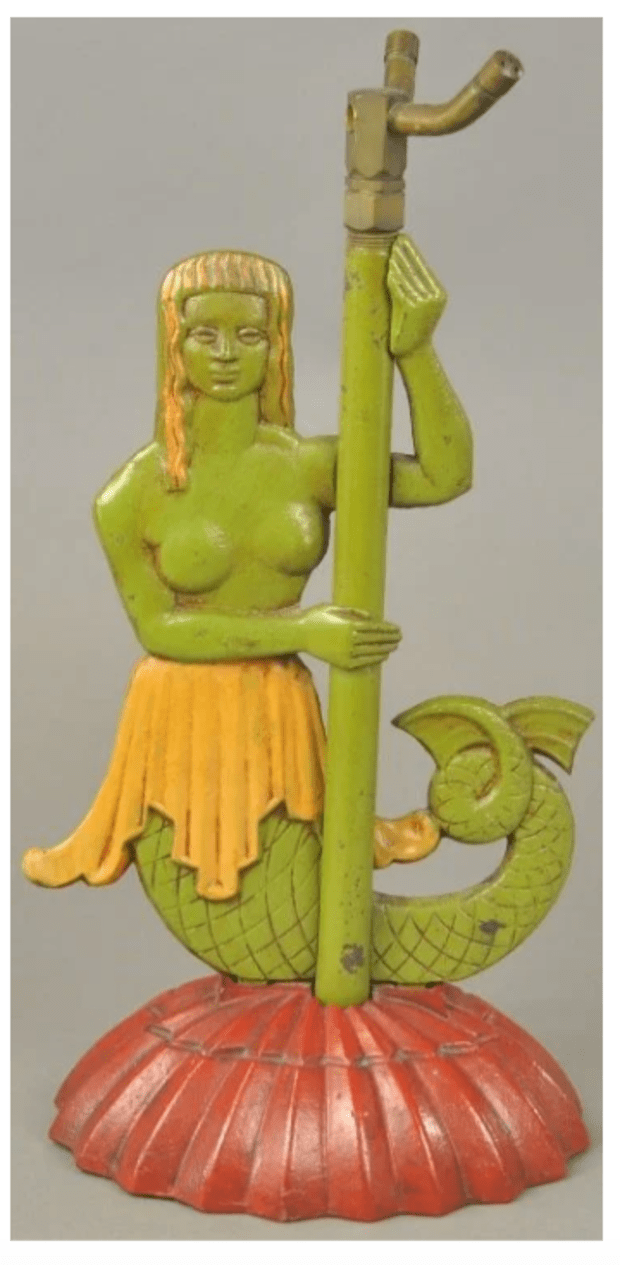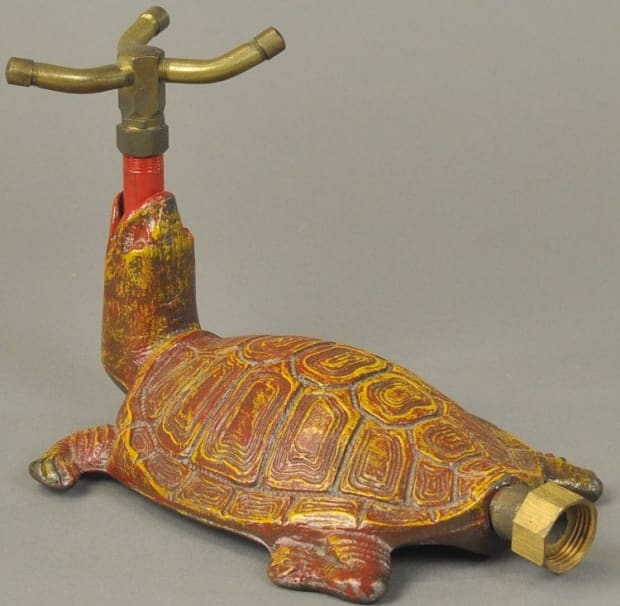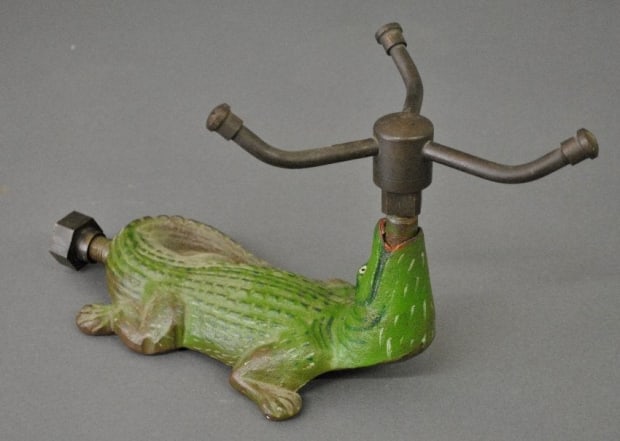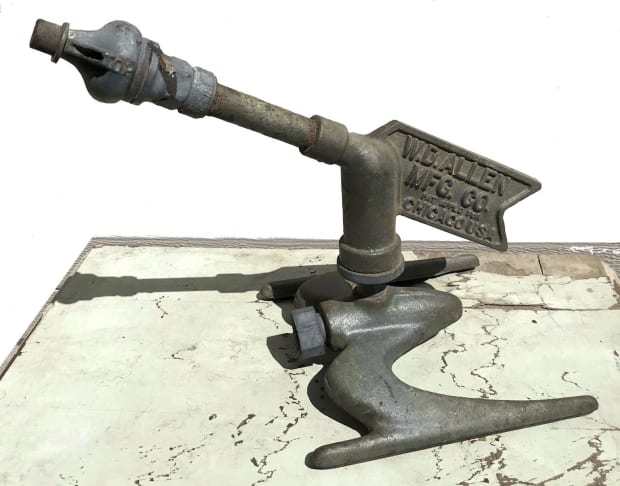#History #Antique #Lawn #Sprinklers
Around 1900, as homes were spreading outward from the inner city, lawns began to come into vogue and mowers were needed to maintain those new lawns. Once established, water was needed to keep these new lawns green.
That required regular watering to prevent grass from turning brown and dying. Thus was a new market born: lawn sprinklers.

Image courtesy of WorthPoint
Lawns first appeared in France and spread to Great Britain and the rest of Europe during the 1700s. Lawns most likely appeared as status symbols for the rich. They first emerged as pasture land. Usually, grazing sheep or other farm animals were utilized in keeping the grass trimmed. Continuous grazing kept the grassy areas cropped. Another way was by cutting them using a hand scythe. This probably seemed to those watching the ledger sheets, as a waste of manpower, labor that could be used on more financially rewarding efforts.

Image courtesy of Dan Morphy Auctions
All this changed in 1830, with the advent of the invention of mowing machines, more commonly called lawnmowers. Operating a mowing machine required far less time than using the scythe. And mowing left a more manicured lawn.
Now the lord of the manor proudly overlooked his new sign of social status, the large expanse of manicured lawn, surrounding his estate. Lawns soon became play areas. And most likely guests were entertained by playing a game of lawn croquet.
Across the Atlantic, lawns as we know them appeared a little later, and did not begin to crop up in front of middle class homes until after 1865. It wasn’t until around 1900, as homes were spreading outward from the inner city, that people began to really consider taking a look at the idea of a lawn. The suburbs were beginning to develop, and people were looking toward enjoying more time for leisure activities.

Image courtesy of LiveAuctioneers and Bertoia Auctions
Lawn mowers were needed to maintain those new lawns. In the 1890s, steam lawn mowers emerged and in 1902, the first internal combustion gasoline engine was produced commercially.
Around 1920, the first gasoline-powered lawn mower was manufactured in the United States. Lawn sprinklers, again, would be needed to keep all these freshly mowed lawns green.
The first patent for an American made-lawn sprinkler was awarded in 1871. Advertisements for various sprinklers sprouted. Some of the earlier models looked like overly engineered devices.

Image courtesy of Bertoia Auctions
During the 1920s and 1930s, lawn sprinklers were no longer overgrown contraptions, but of smaller, simpler designs. They usually consisted of a cast metal base with two to four rotating arms with a nozzle, usually of brass, on each. Other sprinklers displayed an upward spray of water, as in a fountain. Still others had little propellers that delivered the spray in different patterns, so as not to miss any areas when watering.
Far more interesting, however, were the designs for figural sprinklers made in the shape of frogs, turtles, squirrels and other animals. The figural sprinklers looked great but didn’t necessarily do their job that well.
Lawn sprinklers are also made in other shapes such as tractors and automobiles. Later in the fifties and sixties, sprinklers with plastic bases were introduced to replace cast metal. And although rotary-style sprinklers continued to be manufactured, the oscillating designed model with the sprinkler arm delivering spray in a wave-like pattern became more popular.

Image courtesy of LiveAuctioneers and Bertoia Auctions
In the first half of the twentieth century, several companies, large and small, were manufacturing different models of lawn sprinklers.
The American Brass Manufacturing Company, which started in Cleveland in 1894, produced rotary designed lawn sprinklers. The sprinklers were manufactured with brass nozzles affixed to the ends of rotating arms. Like other companies, American Brass Manufacturing produced a litany of other products: wheel sprockets for trolley cars, brass nozzles for Navy battleships, as well as brass faucets.
The Sunbeam Corporation, which initially was the Chicago Flexible Shaft Company, began producing household appliances under the Sunbeam logo in 1921. The company produced a Rain King brand of revolving lawn sprinkler. These lawn sprinklers can be found in a number of styles. Sunbeam began their manufacture in the early 1930s. They were constructed with a cast metal base and fitted with brass nozzles and were a rotary-type sprinkler. These were solid, heavy-duty lawn sprinklers that could stand up to quite a bit of abuse. That’s probably why they can still be found today.

Image courtesy of LiveAuctioneers and Wiederseim Associates
The L.R. Nelson Manufacturing Company of Peoria, Illinois, originated in 1904. The company developed its first lawn sprinkler in 1906. Unlike a number of other manufacturing companies of the same era, the Nelson Company’s main line of products consisted of lawn sprinklers and nozzles for gardening. The company developed several sizes, styles and models of sprinklers.
Aside from the standard cast metal base style of rotary lawn sprinkler, Nelson also developed one of the first early traveling lawn sprinklers. This style, in the form of a tractor, would wend its way along the lawn, following the pattern selected by the gardener. Over the years, the company manufactured several models with names like Jewell, Green Thumb, as well as a Poppy model – a little tri-leg yellow painted rotary model with rubber wheels.
Nelson, famous for their rotary-style models, also manufactured the early oscillating sprinklers. Many can be found in working condition today. L.R. Nelson was the oldest family-owned sprinkler business until it was acquired by the Bosch Group in 2008.

Image courtesy of Dan Morphy Auctions
The W.D. Allen Company appeared a few years after the end of the Civil War. They distributed just about everything, especially belts and hoses. W.D. Allen supplied all that was needed to equip early fire departments: hoses, fire grenades, lanterns, fireman’s hats and coats, and hose carts and reels.
The company provided all the equipment needed to feed our country’s appetite for growth and keep our young industrialized nation growing; wood and iron pulleys, gearing, radiators, bathtubs, steam whistles, hand tools and lawn mowers. It went on to produce all types of sprinklers, including the lawn type. They sold a number of different models: the Ring and a smaller example, appropriately named the Baby Ring. The two were made of copper and had no movable parts. Both allowed for sprays in cylindrical patterns. The company also offered rotary-style-sprinklers with the standard cast metal base and brass nozzles.

Image courtesy of Made In Chicago Museum
Sears has sold lawn sprinklers under its Craftsman name for several years. Many different styles may be found with the Sears’s Craftsman logo. The cast metal rotary types, as well as the oscillating models, are still sold. They also offer a die cast metal travelling sprinkler in the form of a tractor.
The year was 1948 and gardeners were presented with Melnor’s oscillating sprinkler. It was the first of its kind. Melnor entered the world of lawn sprinklers later than most, but made up for that quickly. They developed the multi-patterned turret sprinkler in 1959. In 1962, the company introduced its traveling sprinkler. Today the Melnor Company is a leading innovator in lawn and garden sprinklers and irrigation.
Vintage lawn sprinklers are great collectibles. Along with collecting them for their unique shapes, they can also be used for their intended purpose: watering one’s lawn or garden. Many of the different sprinklers offered for sale on eBay or other Internet auctions are in their original state. That means much of the original paint may have worn off, and there might be some rust. This is also the condition they’ll sometimes be in when found at a flea market.
The prices are affordable. For example, a cast metal base rotary lawn sprinkler, standing 7 inches tall and manufactured by W.D. Allen, was offered at $40. It is in original condition, with quite a bit of paint wear.
Prices for the three Crescent models by L.R. Nelson range from $20 to $40. And two Poppy models, also by Nelson, are going for $20 and $50, respectively. Two Rain King Models, one by Chicago Flexible Shaft Co. 1927 model with much paint wear sells for $89, and the other, with the Sunbeam name, made after 1930 carries a price of $50.
Sprinklers that were made in the form of flowers and different animals, such as a frog, turtle and even an alligator can command top dollar from collectors. Rare sprinklers in excellent condition can sell for thousands of dollars at auction.
Many enjoy these lawn sprinklers for their unique designs as well as their intrinsic value. Sometimes, the sprinklers are simply displayed on a shelf. Or they are put to use watering lawns. Some collectors prefer to keep them in “as found” condition with some degree of paint wear, while others refurbish them, restoring them to pristine condition.
From the 1930s and especially after World War II, several different companies offered a number of lawn sprinklers. Many of the names attached to those sprinklers were actually short explanations of what the sprinklers could do. Names like “Aero Mist,” “Lawn Master,” “SquareSpray” and the “Rain King” by Sunbeam lived up to their names and did the job of watering lawns for all those years.
Sources: Article: ARTS/ARTIFACTS; They Kept Lawns Green and Children Squealing, by Christa Worthington. Article: A Vintage Crop, by Robert Smaus, L.A. Times, August 19, 1999. Ebay Seller: Miliki’s Shed. Melnor.com. The Lawn; A History of an American Obsession, by Virginia Scott Jenkins 1994. wdallen.com
You May Also Like:
How Jell-O Salads Became Culinary Delights
